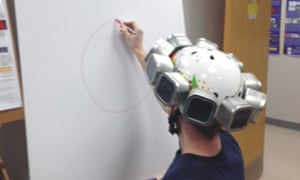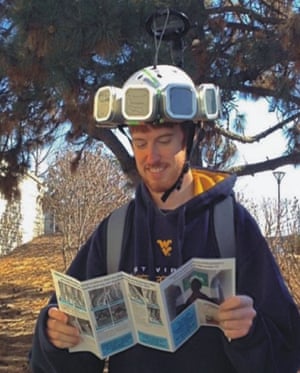A transportable brain-scanning helmet that could be used for rapid brain injury assessments of stroke victims and those felled on the sports pitch or battlefield is being tested by US scientists.
The wearable device, known as the PET helmet, is a miniaturised version of the hospital positron emission tomography (PET) scanner, a doughnut-shaped machine which occupies the volume of a small room.
Julie Brefczynski-Lewis, the neuroscientist leading the project at West Virginia University, said that the new helmet could dramatically speed up diagnosis and make the difference between a positive outcome and devastating brain damage or death for some patients.
“You could roll it right to their bedside and put it on their head,” she said ahead of a presentation at the American Association for the Advancement of Science’s (AAAS) annual meeting in Boston. “Time is brain for stroke.”
Despite being only the size of a motorbike helmet, the new device produces remarkably detailed images that could be used to identify regions of trauma to the brain in the ambulance on the way to hospital or at a person’s bedside. The device is currently being tested on healthy volunteers, but could be used clinically within two years, the team predicted.

Rapidly diagnosing stroke patients, who often wake up unaware of what has happened, is crucial as every passing minute without treatment can result in more extensive and permanent brain damage.
In the hours after a stroke, the brain tissue surrounding the main injury hangs in the balance as it is starved of oxygen due to blockages in the brain’s blood vessels. A rapid surgical intervention, within two to four hours of a stroke, can salvage neurons in the so-called “penumbra” area. After that the risks of brain surgery tend to outweigh any potential benefits to the patient.
“The more you wait, the more that penumbra area gasps and dies,” said Brefczynski-Lewis. “If you can see there’s a bit of activity you might say let’s do an intervention.”
Depending on the brain region affected by stroke, a patient’s speech and language abilities could be saved or paralysis prevented.
In the future, the team said it may be possible to diagnose sports concussion “within minutes”.
“If one can determine quickly whether a head injury is a concussion, then one might be better able to assess if the player, or the soldier, should continue or take time to heal,” said Brefczynski-Lewis.

The helmet was developed in the lab and Brefczynski-Lewis describes it as the equivalent of “going from a big computer to a smartphone”.
The wearable scanner works on the same basic principle as a conventional PET scan. The patient is injected with glucose that has been tagged with a radioactive tracer. Radiation emitted by the tracer is captured by sensors on the helmet, allowing scientists to pinpoint which brain regions are metabolising glucose most rapidly, providing a heatmap of brain activity.
The team were able to miniaturise the scanner by using much smaller detectors fitted with crystal arrays designed to turn PET radiation into measurable electrical signals with a high degree of efficiency.
The device, which can be worn while walking around could also enable scientists to study people’s mental patterns as they move about, socialise and respond to threats in their day-to-day environment. Brefczynski-Lewis said it could also be useful for understanding addiction, where people can respond very differently in a lab setting to in their day-to-day lives where environmental triggers suddenly set off cravings.
“You could put [addicts] in a room similar to where they’ve used drugs before and ask what allows you to have the willpower to walk away,” she said.
A potential limitation is that the helmet is cumbersome, weighing nearly 3kg (6.6lbs) in its current form and up to 9kg (20lb) in an upgraded version designed to give full-brain coverage. The scientists have developed a counterweight system that is pushed along on a stand or carried in a rucksack to avoid the patient being crushed, but Brefczynski-Lewis acknowledges: “you’re probably not walking down the street in Manhattan wearing it”.
Portable brain-scanning helmet could be future for rapid brain injury assessments
Hiç yorum yok:
Yorum Gönder